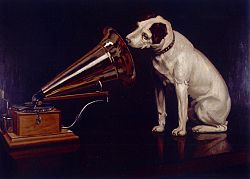In 1945, we had a wind-up gramaphone at Auburn, I think that this might have been built in
prehistoric times!
The idea was that you wound up the spring with a handle, inserted a new steel needle into
the tracking arm, put the record on, carefully place the arm on the lead--in groove of the record, release the brake,
and away you went!
The sound would emerge from a horn, or through an internal mechanical sound-box,and the needle
would last for a few records when it would have to be replaced. Needles were sold in small tins about the same size as
a matchbox, at record shops.
Those old records were 78 rpm, and I still have many of them.
I bought many 78s in the 1950s.
RADIOGRAMS
A radiogram is a now old-fashioned
piece of furniture that combined a valve radio and record player. The word radiogram is a portmanteau of "radio" and
"gramaphone"
Radiograms reached their peak of popularity in the post-war era, supported by a rapidly growing
interest in records. Originally they were styled in polished wood to blend with the furniture styles of the 1930s, with many
styled by the leading designers of the day. An expensive instrument of entertainment for the house, fitted with a larger loudspeaker
than the domestic radio, the radiogram soon began to develop features such as the record autochanger, which would accept 6
or 7 records and play them one after another.
Certain recordings could be ordered as a box set which would combine the recorded piece in
order, to suit an autochanger set-up.
In the 1940s and 1950s, sales of the radiogram, coupled with the then-new FM waveband, and
the advent of the 45 rpm single and the LP record, meant that many manufacturers considered the radiogram to be more important
than the fledgling television set sales. Later models took on the modern lines, piano gloss finish and plastic and gilt trim
of the 1960s.
Stereogram versions became available to take advantage of stereo records. When valve radio
development ended in the late 1960s and transistors began to take over, radiograms started to become obsolete. By the late
1970s, they had been replaced by more compact equipment, such as the Hi-Fi and the music centre.
The first 45 rpm single I bought was from Bill Haley and his
Comets, which featured "Rock Around the Clock" and "Thirteen
Women", released on the Decca label in 1954.
I have hundreds of 33 LPs, either 10" or 12, dating from the 1950s to the 1980s.
One of these is the LP of the opening ceremony of the Melbourne Olympic Games held in November
1956.
I built many audio amplifiers in the 1950s to play the LPs - I set up a thriving mini-business
to build amplifiiers for my friends!
The popular Radio and Hobbies magazines published many circuits and
how-to-build articles about audio amplifiers in the 1940s to the 1960s, ranging from small single ended amps to monstrous
push-pull units, as well as designs for public address systems and organs The "house brand" was known as the Playmaster.
Building audio amplifiers was a popular pastime in the 1950s, as there were few commercial
amps available. These were constructed either from kit-sets or by purchasing the individual components from radio parts
suppliers.
In the 1950s and onwards, there was strong interest in buying LPs of the sound tracks of the
latest movies - I have LPs for The King and I, Kismet, The Sound of Music, Three Coins in the Fountain, from my collectiion
of several hundred!
To support my interest in record playing, in 1956 a mate's father, a carpenter, built me a
beautuiful wooden speaker enclosure, which held my Rola 12M 12"
speaker.
I still have that enclosure and speaker, which is used daily for my shortwave work, connected
to one of my all-band communications receivers!

